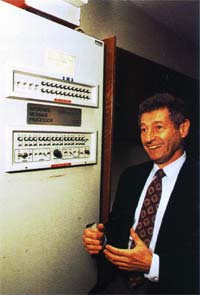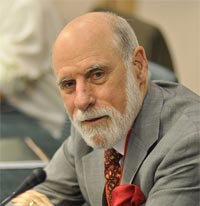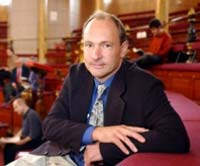Who invented the Internet?
A single person did not create the Internet that we know and use today. Below is a listing of different people who have helped contribute to and develop the Internet.
The idea
The initial idea of the Internet is credited to Leonard Kleinrock after he published his first paper entitled "Information Flow in Large Communication Nets" on May 31, 1961.
In 1962, J.C.R. Licklider became the first Director of IPTO and gave his vision of a galactic network. Also, with ideas from Licklider and Kleinrock, Robert Taylor helped create the idea of the network that later became ARPANET.
Initial creation
The Internet as we know it today first started being developed in the late 1960's in California in the United States.
In the summer of 1968, the Network Working Group (NWG) held its first meeting, chaired by Elmer Shapiro, at the Stanford Research Institute (SRI). Other attendees included Steve Carr, Steve Crocker, Jeff Rulifson, and Ron Stoughton. In the meeting, the group discussed solving issues related to getting hosts to communicate with each other.
In December 1968, Elmer Shapiro with SRI released a report "A Study of Computer Network Design Parameters." Based on this work and earlier work done by Paul Baran, Thomas Marill and others, Lawrence Roberts and Barry Wessler created the Interface Message Processor (IMP) specifications. Bolt Beranek and Newman, Inc. (BBN) was later awarded the contract to design and build the IMP subnetwork.
General public learns about Internet
The UCLA (University of California, Los Angeles) put out a press release introducing the public to the Internet on July 3, 1969.
First network equipment
 On August 29, 1969, the first network switch and the first piece of network equipment called "IMP" (Interface Message Processor) is sent to UCLA.
On August 29, 1969, the first network switch and the first piece of network equipment called "IMP" (Interface Message Processor) is sent to UCLA.
On September 2, 1969, the first data moves from the UCLA host to the switch. The picture to the right is Leonard Kleinrock next to the IMP.
The first message and network crash
On Friday October 29, 1969 at 10:30 p.m., the first Internet message was sent from computer science Professor Leonard KleinRock's laboratory at UCLA, after the second piece of network equipment was installed at SRI. The connection not only enabled the first transmission to be made, but is also considered the first Internetbackbone.
The first message to be distributed was "LO", which was an attempt at "LOGIN" byCharley S. Kline to log into the SRI computer from UCLA. However, the message was unable to be completed because the SRI system crashed. Shortly after the crash, the issue was resolved, and he was able to log into the computer.

E-mail is developed
Ray Tomlinson sends the first network e-mail in 1971. It's the first messaging system to send messages across a network to other users.
TCP is developed
 Vinton Cerf and Robert Kahn design TCP during 1973 and later publish it with the help of Yogen Dalal and Carl Sunshine in December of 1974 in RFC 675. Most people consider these two people the inventors of the Internet.
Vinton Cerf and Robert Kahn design TCP during 1973 and later publish it with the help of Yogen Dalal and Carl Sunshine in December of 1974 in RFC 675. Most people consider these two people the inventors of the Internet.First commercial network
A commercial version of ARPANET, known as Telenet, is introduced in 1974 and considered to be the first Internet Service Provider (ISP).
Ethernet is conceived
The Modem is introduced
Dennis Hayes and Dale Heatherington released the 80-103A Modem in 1977. TheModem and their subsequent modems become a popular choice for home users to connect to the Internet and get online.
TCP/IP is created
In 1978, TCP splits into TCP/IP, driven by Danny Cohen, David Reed, and John Shoch to support real-time traffic. The creation of TCP/IP help create UDP and is later standardized into ARPANET on January 1, 1983. Today TCP/IP is still the primaryprotocol used on the Internet.
DNS is introduced
Paul Mockapetris and Jon Postel introduce DNS in 1984, which also introduces thedomain name system. The first Internet domain name, symbolics.com, is registered on March 15, 1985 by Symbolics, a Massachusetts computer company.
First commercial dial-up ISP
The first commercial Internet Service Provider (ISP) in the US, known as "The World", is introduced in 1989. The World was the first ISP to be used on what we now consider to be the Internet.
HTML
 In 1990, Tim Berners-Lee develops HTML, which made a huge contribution to how we navigate and view the Internet today.
In 1990, Tim Berners-Lee develops HTML, which made a huge contribution to how we navigate and view the Internet today.WWW
Tim Berners-Lee introduces WWW to the public on August 6,1991. The World Wide Web (WWW) is what most people today consider the "Internet" or a series of sites and pages that are connected with links. The Internet had hundreds of people who helped develop the standards and technologies used today, but without the WWW, the Internet would not be as popular as it is today.
First graphical Internet browser
 Mosaic is the first widely used graphical World Wide Web browser developed and first released on April 22, 1993 by theNCSA with the help of Marc Andreessen and Eric Bina. A big competitor to Mosaic was Netscape, which was released a year later. Today, most of the Internet browsers we use today, e.g.Internet Explorer, Chrome, Firefox, etc., got their inspiration from the Mosaic browser.
Mosaic is the first widely used graphical World Wide Web browser developed and first released on April 22, 1993 by theNCSA with the help of Marc Andreessen and Eric Bina. A big competitor to Mosaic was Netscape, which was released a year later. Today, most of the Internet browsers we use today, e.g.Internet Explorer, Chrome, Firefox, etc., got their inspiration from the Mosaic browser.Java and JavaScript
Originally known as oak, Java is a programming language developed by James Gosling and others at Sun Microsystems. It was first introduced to the public in 1995and today is widely used to create Internet applications and other software programs.
JavaScript was developed by Brendan Eich in 1995 and originally known asLiveScript. It was first introduced to the public with Netscape Navigator 2.0 and was renamed to JavaScript with the release of Netscape Navigator 2.0B3. JavaScript is aninterpreted client-side scripting language that allows a web designer the ability to insert code into their web page.
Related Questions
That is a great overview, but who are the key inventors of the Internet?
If you had to isolate the key inventors of the Internet, it would have to be two people:Vinton Cerf and Robert Kahn. The WWW, which is different from the Internet, but what most people think of as the "Internet", was invented later by Tim Berners-Lee.
But I thought Al Gore invented the Internet.
Al Gore coined the term Information Superhighway, but he did not invent the Internet.
Additional information
- Overall history of the Internet.
- See the Internet definition for further information and related linksv
Heat energy
 Most of us use the word ‘heat’ to mean something that feels warm, but science defines heat as the flow of energy from a warm object to a cooler object.
Most of us use the word ‘heat’ to mean something that feels warm, but science defines heat as the flow of energy from a warm object to a cooler object.
Actually, heat energy is all around us – in volcanoes, in icebergs and in your body. All matter contains heat energy.
Heat energy is the result of the movement of tiny particles called atoms, molecules or ions in solids, liquids and gases. Heat energy can be transferred from one object to another, and the transfer or flow due to the difference in temperature between the two objects is called heat.
Moving particles
Matter is all around you. It is everything in the universe – anything that has both mass and volume and takes up space is matter. Matter exists in different physical forms – solids, liquids and gases.
All matter is made of tiny particles called atoms, molecules and ions. These tiny particles are always in motion – either bumping into each other or vibrating back and forth. It is the motion of particles that creates a form of energy called heat (or thermal) energy that is present in all matter.
The particles in solids are tightly packed and can only vibrate. The particles in liquids also vibrate but are able to move around by rolling over each other and sliding around. In gases, the particles move freely with rapid, random motion.
Transferring heat energy – particles in collision
At higher temperatures, particles have more energy. Some of this energy can be transmitted to other particles that are at a lower temperature. For example, in the gas state, when a fast moving particle collides with a slower moving particle, it transfers some of its energy to the slower moving particle, increasing the speed of that particle.
With billions of moving particles colliding into each other, an area of high energy will slowly transfer across the material until thermal equilibrium is reached (the temperature is the same across the material).
Changing states by heat transfer
Faster moving particles ‘excite’ nearby particles. If heated sufficiently, the movement of particles in a solid increases and overcomes the bonds that hold the particles together. The substance changes its state from a solid to a liquid. If the movement of the particles increases further in the liquid, then a stage is reached where the substance changes into a gas.
Three ways of transferring heat energy
All heat energy, including heat generated by fire, is transferred in different ways:
| |
Convection transfers heat energy through the air (and liquids). As the air heats up, the particles move further apart and become less dense, which causes the air to rise. Cooler air below moves in and heats up, creating a circular motion. The warm air circles and heats the room.
| |
Conduction transfers heat energy through one substance to another when they are in direct contact. The moving molecules of a warm material can increase the energy of the molecules in a cooler material. Since particles are closer together, solids conduct heat better than liquids or gases.
| |
Radiation is the heat that we feel coming from a hot object. It warms the air using heat waves (infrared waves) that radiate out from the hot object in all directions until it is absorbed by other objects. Transfer of heat by radiation travels at the speed of light and goes great distances.
With a log fire, the air in the room above the fire is heated and rises to create convection currents. The heat felt directly from the fire is transmitted to us through radiation. Conduction helps to keep a fire going by transferring heat energy directly from the wood to neighbouring wood in the fire
|
An effect of heat – expansion
When gases, liquids and solids are heated, they expand. As they cool, they contract or get smaller. The expansion of the gases and liquids is because the particles are moving around very fast when they are heated and are able to move further apart so they take up more room. If the gas or liquid is heated in a closed container, the particlescollide with the sides of the container, and this causes pressure. The greater the number of collisions, the greater the pressure.
Sometimes when a house is on fire, the windows will explode outwards. This is because the air in the house has been heated and the excited molecules are moving at high speed around the room. They are pushing against the walls, ceiling, floor and windows. Because the windows are the weakest part of the house structure, they break and burst open, releasing the increased pressure.
THE
DEPED VISION AND MISSION
VISION
We dream of Filipinos
who passionately love their country
and whose values and competencies
enable them to realize their full potential
and contribute meaningfully to building the nation.
As a learner-centered public institution,
the Department of Education
continuously improves itself
to better serve its stakeholders.
We dream of Filipinos
who passionately love their country
and whose values and competencies
enable them to realize their full potential
and contribute meaningfully to building the nation.
As a learner-centered public institution,
the Department of Education
continuously improves itself
to better serve its stakeholders.
MISSION
To protect and promote the right of every Filipino to quality, equitable, culture-based, and complete basic education where:
Students learn in a child-friendly, gender-sensitive, safe, and motivating environment.
Teachers facilitate learning and constantly nurture every learner.
Administrators and staff, as stewards of the institution, ensure an enabling and supportive environment for effective learning to happen.
Family, community, and other stakeholders are actively engaged and share responsibility for developing life-long learners.
To protect and promote the right of every Filipino to quality, equitable, culture-based, and complete basic education where:
Students learn in a child-friendly, gender-sensitive, safe, and motivating environment.
Teachers facilitate learning and constantly nurture every learner.
Administrators and staff, as stewards of the institution, ensure an enabling and supportive environment for effective learning to happen.
Family, community, and other stakeholders are actively engaged and share responsibility for developing life-long learners.



